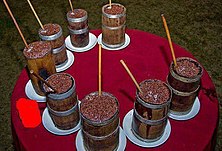Raksi (Devanagari:रक्सी) or Rakshi (Bantawa language: Hengmawa/Hengma, Limbu language: Sijongwaa aara,[1] Nepal Bhasa: aila) is the Nepali term for a traditional distilled alcoholic beverage in Nepal, India (Darjeeling, Sikkim) and Tibet. It is often made at home.
 Rakshi in a bowl | |
| Type | Alcoholic beverage |
|---|---|
| Country of origin | Limbuwan (present day Eastern Nepal, Sikkim) |
| Region of origin | |
| Introduced | Limbu people |
| Related products | Chhaang |
Raksi is a strong drink, clear like vodka or gin, tasting somewhat like Japanese sake. It is usually made from kodo millet (kodo) or rice; different grains produce different flavors.[2] It is made by distilling a chhaang, a brewed alcoholic drink.[3] The Limbus and Kirati people , for whom it is a traditional beverage,[4] drink tongba and raksi served with pieces of pork, water buffalo or goat meat sekuwa.[5] For the Newars, aila is indispensable during festivals and various religious rituals as libation, prasad or sagan.

In CNN's list of the world's 50 most delicious drinks, raksi was ranked 41st and was described as follows: "made from millet or rice, raksi is strong on the nose and sends a burning sensation straight down your throat that resolves itself into a surprisingly smooth, velvety sensation. Nepalese drink this home brew to celebrate festivals, though some think that the prized drink itself is the reason to celebrate."[6]
Because of its popularity, various temperance movements exist in Nepal, including various women's groups. Raksi, however, remains an important requirement of various religious rituals and social events, due in part perhaps to its antiseptic properties.
GC-MS based metabolomics revealed medicinal compounds present in raksi collected from high altitudes of Singalila Ridge of the Himalayas. Study claims raksi contains compounds which are useful as a remedy of high altitudes sickness.[7]
Serving
editRaksi is often served in a bhatti glass and during special occasions, the drink is poured from a great height via a pitcher with a small spout, making an entertaining spectacle.
Production
editRaksi is produced, sold and mostly consumed at rustic distilleries scattered around the countryside. Usually it is not aged before consumption. A large amount of wood is used in the distillation process.[8]
See also
edit- Alcohol in Nepal
- Ara, a Bhutanese drink
- Chhaang, a Tibetan and Nepalese drink
- List of Tibetan dishes
References
edit- ^ Ethnic Fermented Foods and Alcoholic Beverages of Asia, Front Cover By Jyoti Prakash Tamang, Springer, 5 Aug 2016 - Technology & Engineering, P.107
- ^ "Nepal: Liquor". Archived from the original on 9 March 2016.
- ^ The Rough Guide to Nepal, Apa Publications (UK), 2018 ISBN 1786719975.
- ^ p.67 Land and Social Change in East Nepal: A Study of Hindu-Tribal Relations. Lionel Caplan.
- ^ p.34 Kinship and Marriage Among the Limbu of Eastern Nepal: A Study. Rex Lee Jones - 1973
- ^ "World's 50 most delicious drinks". 12 July 2017. Retrieved 3 November 2018.
- ^ Majumder, Soumya; Ghosh, Arindam; Chakraborty, Sourav; Saha, Sumedha; Bhattacharya, Malay (2021-08-14). "Metabolomics affirms traditional alcoholic beverage raksi as a remedy for high-altitude sickness". Journal of Ethnic Foods. 8 (1): 17. doi:10.1186/s42779-021-00094-4. ISSN 2352-6181.
- ^ "Terraced Fields and Natural Disasters in Nepal -- An Fuyusawa". www.natureinterface.com. Archived from the original on 20 November 2008. Retrieved 3 November 2018.